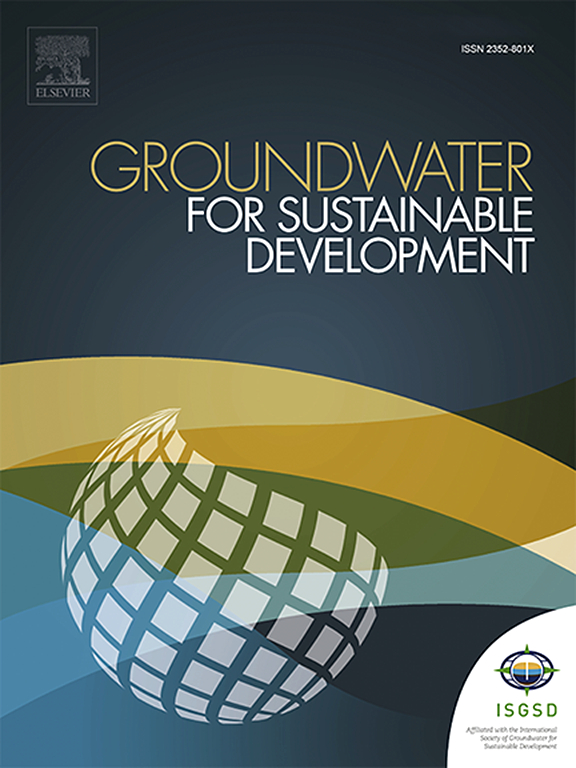Temporal Fractionation Models for Depicting Mass Transfer Limiting Conditions of Multispecies Transport in Porous Media
IF 4.9
Q2 ENGINEERING, ENVIRONMENTAL
引用次数: 0
Abstract
Numerical modeling is widely recognized as the most flexible and reliable method for predicting the flow and transport of contaminants in the sub-surface under highly heterogenous and complex environment. Many times, the classical advection-dispersion model needs to be customarily modified and solved in order to address these complexities in porous media at least in Darcy-scale domain. This is particularly crucial when different mass transfer processes happen at different rates and temporal scales. In an attempt to depict the limiting conditions of multispecies mass transfer within the temporal scales, the present study simulates the fractional mass transfer phenomena in porous media by considering different levels of time fractionation by solving a set of partial differential equations using finite difference method. The incorporation of the time fractionation provides new insights to the solute transport behavior in complex systems, highlighting the changes in the temporal concentration profiles and tailing phenomena. Further, the sensitivity of the flow and transport parameters such as flow velocity, dispersion coefficient, retardation coefficient and contaminant reaction rates are found to be enhanced within the flow domain. Based on the direct proportion observed between the time fractionation scale and the contaminant propagation level (in terms of peak and skewness), the present study postulates the significance of design and adjustment of suitable temporal fractionation for accurately profiling multi-species transport in different types of porous domains.

描述多孔介质中多组分传质极限条件的时间分馏模型
数值建模被公认为是预测高度异质和复杂环境下污染物在地下流动和迁移的最灵活、最可靠的方法。很多时候,为了解决多孔介质中的这些复杂问题,至少在达西尺度域中,需要对经典的平流-扩散模型进行习惯性修改和求解。当不同的传质过程以不同的速率和时间尺度发生时,这一点尤为重要。为了描述时间尺度内多物种传质的限制条件,本研究通过考虑不同程度的时间分馏,使用有限差分法求解一组偏微分方程,模拟多孔介质中的分数传质现象。时间分馏的加入为复杂系统中的溶质传输行为提供了新的见解,突出了时间浓度剖面的变化和尾流现象。此外,在流域内,流速、分散系数、延缓系数和污染物反应速率等流动和传输参数的敏感性也得到了提高。根据观察到的时间分馏尺度与污染物传播水平(在峰值和偏度方面)之间的直接比例关系,本研究推测了设计和调整合适的时间分馏对准确剖析不同类型多孔域中多物种迁移的重要意义。
本文章由计算机程序翻译,如有差异,请以英文原文为准。
求助全文
约1分钟内获得全文
求助全文
来源期刊

Groundwater for Sustainable Development
Social Sciences-Geography, Planning and Development
CiteScore
11.50
自引率
10.20%
发文量
152
期刊介绍:
Groundwater for Sustainable Development is directed to different stakeholders and professionals, including government and non-governmental organizations, international funding agencies, universities, public water institutions, public health and other public/private sector professionals, and other relevant institutions. It is aimed at professionals, academics and students in the fields of disciplines such as: groundwater and its connection to surface hydrology and environment, soil sciences, engineering, ecology, microbiology, atmospheric sciences, analytical chemistry, hydro-engineering, water technology, environmental ethics, economics, public health, policy, as well as social sciences, legal disciplines, or any other area connected with water issues. The objectives of this journal are to facilitate: • The improvement of effective and sustainable management of water resources across the globe. • The improvement of human access to groundwater resources in adequate quantity and good quality. • The meeting of the increasing demand for drinking and irrigation water needed for food security to contribute to a social and economically sound human development. • The creation of a global inter- and multidisciplinary platform and forum to improve our understanding of groundwater resources and to advocate their effective and sustainable management and protection against contamination. • Interdisciplinary information exchange and to stimulate scientific research in the fields of groundwater related sciences and social and health sciences required to achieve the United Nations Millennium Development Goals for sustainable development.
 求助内容:
求助内容: 应助结果提醒方式:
应助结果提醒方式:


